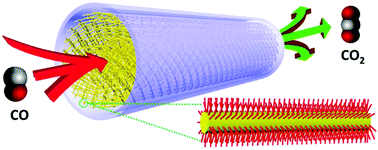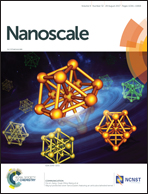Crystalline (Ni1−xCox)5TiO7 nanostructures grown in situ on a flexible metal substrate used towards efficient CO oxidation†
Abstract
Severe environmental contamination and the urgent demand for a clean atmosphere require an efficient and low-cost solution to address problems such as CO emission. In this study, we report the in situ integration of non-noble (Ni1−xCox)5TiO7 nanostructures with different Co concentrations and tunable size on a flexible metal network support using a conventional PEO method; we further report their utilization for efficient CO oxidation. It was found that the Co/Ni ratios in the original electrolyte precursors directly result in the different size and morphology evolution. The (Ni1−xCox)5TiO7 nanowire arrays with x = 0.16 exhibit the best performance towards CO catalytic oxidation along with a good catalytic stability. Further analysis using XPS indicates that the CO catalytic oxidation was mainly determined by the amount of defective oxygen, lattice oxygen and surface area. The single crystal nature, large surface area, excellent CO catalytic capability and strong substrate adhesion of the (Ni1−xCox)5TiO7 nanostructures on a flexible metal substrate will open up more applications in CO oxidation ranging from processing autovehicle exhaust to chemical gas emissions in the industry.



 Please wait while we load your content...
Please wait while we load your content...